Simon Property Group: Not The Best Investment At This Point
Summary
- Simon Property Group reported second quarter results and is still growing in the single digits and with a solid pace.
- Additionally, base minimum rent and occupancy rates are also improving.
- However, the looming recession should make us rather cautious, and the stock seems to be a bit overvalued at this point.

ronniechua
Usually, I try to focus in my articles on companies with a wide economic moat around the business, but from time to time, I also cover companies not really fitting that description. One example is Simon Property Group, Inc. (NYSE:SPG) – a business that is certainly well run and has been a good investment in the past, but a business where it is difficult to argue for a wide economic moat around the business.
While I have been bullish about Simon Property Group in the past, I changed my rating to “Hold” in my last article, which was published in December 2023. In the last eight months, however, the stock increased 19.5% in value and while we can argue that my “Hold” rating was probably too cautious, the stock also slightly outperformed the S&P 500 (SPY). In my last article, I finished with the following conclusion:
Combining these aspects, a potential recession on the horizon, Simon Property Group already having trouble to grow with a high pace in the last few years and analysts also being cautious, we could make the case that Simon Property Group seems fairly valued at this point. And although I was bullish in my last article when Simon Property Group was trading more or less for the same price, I would switch my rating to “Hold” again.
Although I have been wrong in the last eight months, my opinion about Simon Property Group remains more or less the same. And as the company recently reported second quarter results for fiscal 2024, let’s take another look at the stock and business.
Quarterly Results
We start by looking at the second quarter results and while revenue did beat expectations by $140 million, the company slightly missed FFO estimates by $0.04 per share. And when looking at second quarter results, revenue increased from $1,369 million in Q2/23 to $1,458 million in Q2/24 – resulting in 6.5% year-over-year growth. Such a growth rate can be seen in-line with past growth rates, as quarterly revenue growth in the last ten quarters fluctuated between 1.48% and 9.11%.
And while “management fees and other revenues” declined slightly, “Other Income” increased 34.8% year-over-year to $109.3 million. And lease income also increased 4.9% year-over-year to $1,316 million. Operating income (before other items) increased from $657.9 million in the same quarter last year to $754.1 million this quarter – resulting in 14.6% year-over-year growth. And finally, diluted earnings per share also increased slightly from $1.49 in Q2/23 to $1.51 in Q2/24.

Simon Property Group Q2/24 Supplemental Material
One of the most important metrics Simon Property Group is reporting is FFO per share (basic and diluted), which increased slightly from $2.82 in Q2/23 to $2.90 in Q2/24. Overall, these are solid results, and we should be neither disappointed nor excited about the second quarter. And although competitors like Realty Income Corporation (O) or Kimco Realty Corporation (KIM) reported (much) higher growth rates, Simon Property Group is not a terrible business.
And while Simon Property Group reported solid single digit growth rates for most items on the income statement, the guidance was also narrowed (and raised slightly for funds from operations). The company is now expecting net income per share being in a range of $7.37 to $7.47 ($7.38 to $7.53 in a previous guidance) and FFO per share to be in a range of $12.80 to $12.90 (previous guidance of $12.75 to $12.90). During the last earnings call, CFO Brian McDade commented on the update guidance:
We are increasing our full-year 2024 guidance range to $12.80 to $12.90 per share compared to $12.51 last year. This is an increase of $0.05 at the bottom end of the range and $0.02 at the midpoint and reflects overcoming approximately $0.15 per share from certain retailer restructurings, lower lease settlement and land sales, land sales income this year.
All in all, CEO David Simon sounded extremely optimistic during the last earnings call and made the following statement about the business being in great shape:
Good evening, everyone. I'm pleased with our financial and operational performance in the second quarter. We are seeing increased leasing volumes, occupancy gains, shopper traffic, and retail sales volumes resulted in the company's highest level of real estate NOI for the second quarter in our company's history. Demand for our space from a broad spectrum of tenants is strong and steady.
Further Metrics
Aside from looking at the income statement, the occupancy rates and development activity are also important as both have a huge impact on the performance of the business. Let’s start by looking at the occupancy rates Simon Property Group is reporting. And the good news is that occupancy rate increased for all types of outlets – it increased for U.S. Malls and Premium Outlets (from 94.7% on June 30, 2023 to 95.6% on June 30, 2024), for U.S. TRG (from 93.7% to 94.7%) and for The Mills (from 97.3% to 98.2%).
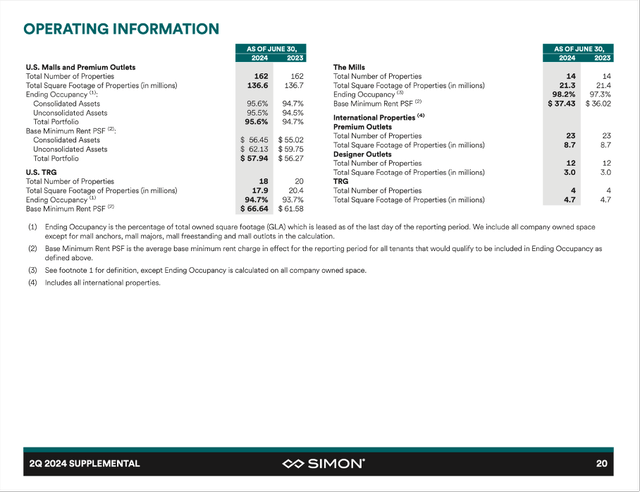
Simon Property Group Q2/24 Supplemental Material
While the occupancy rate is important as it has an impact on the revenue Simon Property Group can generate, the base minimum rent also has an impact. And for U.S. Malls and Premium Outlets, the base minimum rent increased 3.0% year-over-year from $56.27 to $57.94. Base minimum rent for “The Mills” also increased 3.9% year-over-year from $36.02 at the end of June 2023 to $37.43 at the end of June 2024. And base minimum rent for U.S. TRG increased from $61.58 to $66.64 during the last twelve months, resulting in 8.2% year-over-year growth. CFO McDade also commented on the lease momentum during the earnings call:
Continued leasing momentum, resilient consumer spending and operational excellence delivered results exceeding our plan for the quarter. Portfolio NOI, which includes our international properties at constant currency, grew 4.8% for the quarter.
(…)
As David mentioned, leasing momentum continued across the portfolio. We signed more than 1,400 leases for approximately 4.8 million square feet in the quarter. Approximately 30% of our leasing activity in the second quarter was new deal volume. Our traffic in the second quarter was up 5% compared to last year.
Aside from improving the occupancy rate and charging higher rates, the company can also grow revenue by opening new malls. During the last earnings call, management also commented on its new developments:
We will open our Tulsa premium outlets on August 15th at 100% leased and we will also open a significant expansion at Busan Premium Outlets in South Korea this fall. We also started construction in the quarter on our first phase of a new luxury residential development at Northgate Station. This project will include 234 units and adds other elements that further transforms Northgate into the ultimate live, work, skate, stay and shop destination. At the end of the quarter, new development and redevelopment projects were underway across all platforms in the US and internationally with our share of net cost of $1.1 billion and a blended yield of 8%.
In combination with the occupancy rates and base minimum rent mentioned above, we have reasons to be optimistic about Simon Property Group. When asked about the occupancy rate at the end of the year, management seems optimistic it might improve further. CFO Brian McDade commented:
I think we're pretty comfortable thinking that we're going to end the year north of 96%. Certainly still a little bit of noise out there, but given the robust demand in the type of environment we're in, we think we're north of 96% by the end of the year.
Raising Dividend Again
And as long as we are talking about good news, we can also mention that Simon Property Group raised the dividend once again. Since Simon Property Group suspended the dividend in 2020 during the COVID-19 crisis for one quarter, it is the 11th time the company has raised the dividend. Of course, the last few dividend increases have been rather small raises (most in the low single digits), but a constantly increased dividend can be seen as a sign of confidence by management.
Right now, the company is paying a quarterly dividend of $2.05 (compared to the previous dividend of $2.00 and $1.90 in the same quarter last year). The current dividend is resulting in an annual dividend of $.820 and a dividend yield of 5.4%.
Recession
And while other investors might disagree, I still see the United States being close to a recession. I articulated this point of view, especially since the yield curve inverted back in 2022, and I admit it has been a very long time since that first warning sign and as far as we know, the United States is still not in a recession.
The United States is still not in a recession, but it seems like the next warning sign, which is almost always occurring before a recession, is very close – the yield curve is re-inverting again and when looking at the 10-year vs. 2-year treasury yield we are close to zero again.

FRED
Aside from interest rates reacting to economic data and indicating a recession, the FED is often also reacting to the economy struggling and is starting to lower interest rates to stimulate the economy. The so-called FED Pivot (the FED switching from increasing interest rates to lower interest rates again) is another step, usually occurring before the start of a recession. And for September, analysts and market participants seem to be 100% certain a rate cut will happen. And when looking at data from the CME Group, interest rates are expected to be lowered several times in the coming months and not only by 25 basis points.
I often point out that the initial claims for unemployment insurance can be another warning sign – but a rather weak one. Nevertheless, the numbers are increasing constantly since January 2024 (I am looking at the 4-week average to level out fluctuations).
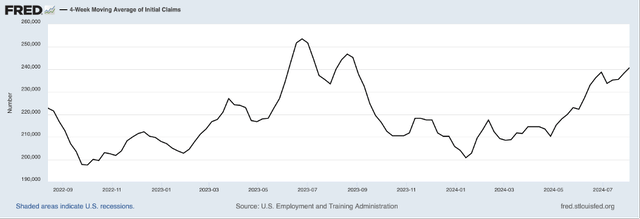
FRED
And the increasing unemployment claims might go hand-in-hand with the increasing number of bankruptcies. A high number of businesses going bankrupt will lead to difficulties for some people to find a new job right away.
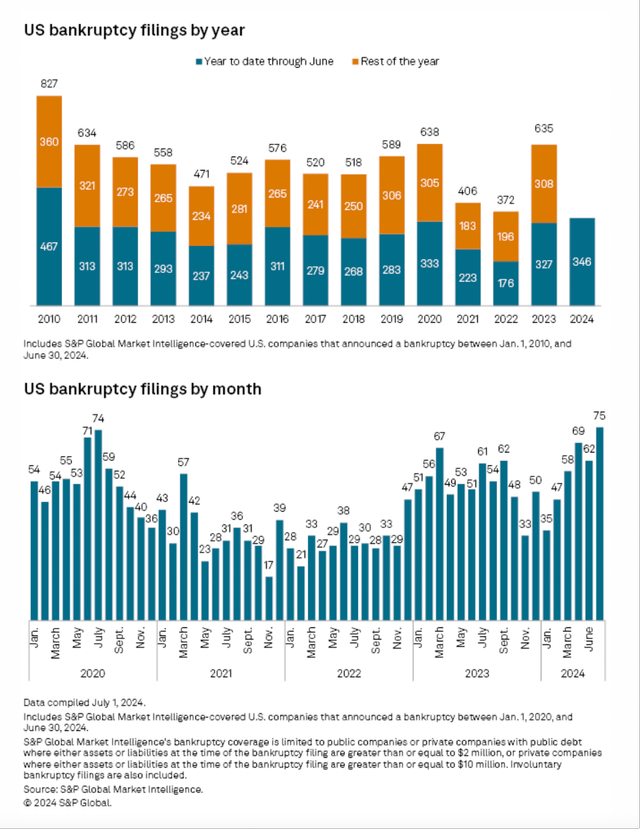
S&P Global
And when looking at the year to date through June data by S&P Global, we see the highest number of bankruptcies in 2024 since 2010 and the last monthly data from June 2024 is also the highest (75 bankruptcies) since 2020.
And not very surprising, management was also asked about a potential consumer-led recession during the earnings call. The recent sell-off has catapulted recession fears into the mainstream media again and when looking at data from Google Trends and the search volume for the term “recession” the search volume wasn’t this high since mid-2022 and especially last Monday the search volume for the term peaked. And when asked about this risk, CEO Simon commented:
So look, I think we've been pretty consistent for well over a year that the lower-income consumer has been under pressure for quite some time, primarily because of the inflation that's affected them. So that continues to be the case, they are very focused on managing their bills and discretionary expenditures have been obviously not where we'd like to see them.
So we're optimistic that we're going to cycle out of that from the lower-end consumer as given the inflation picture that we see now, which is relatively benign. It's way too early, Jeff. We haven't seen a slowdown in the higher-end consumer. Obviously, the market is in an interesting point. We have not seen the wealth impact at all impact that higher-end consumer. So we're still pretty sanguine about it. I think, as you know, we kind of budgeted at the beginning of the year flat sales.
When looking at the past performance, and the recently reported numbers, we should dismiss all these warnings as the numbers are showing a business in great shape. However, these numbers can be deceptive, as it often takes several quarters before a struggling economy becomes obvious. And especially the rising number of bankruptcies should be a warning sign for Simon Property Group.
Intrinsic Value Calculation
And as always, we will finish the analysis by calculating an intrinsic value for the stock. Once again, we are using the last reported number of diluted outstanding shares (375 million) and a 10% discount rate. Additionally, we are calculating with the free cash flow of the last four quarters, which was $3,053 million. And when looking at the free cash flow in the last few years, the amount was mostly fluctuating around $3 billion, making the TTM number a good basis for the calculation.
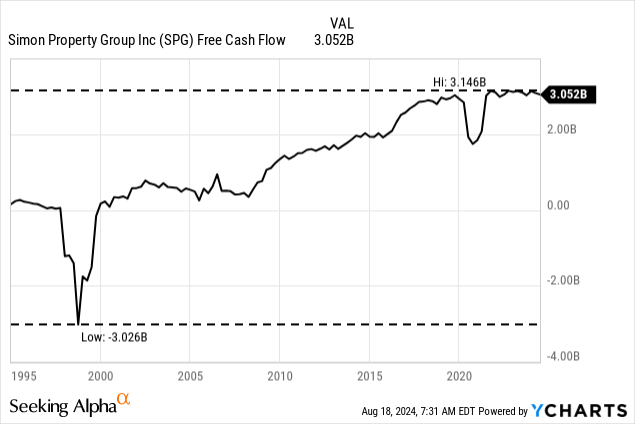 Data by YCharts
Data by YCharts
In the case of Simon Property Group, I would be rather cautious and calculate only with 3% growth till perpetuity, as the company has no economic moat around its business and did not really grow at a higher pace in the recent past. When calculating with these assumptions, we get an intrinsic value of $116.27, and the stock is clearly overvalued at this point.
When looking at analysts’ estimates for funds from operations, they are expecting only a CAGR of 1.7% for the years until fiscal 2033. On the other hand, Simon Property Group could grow earnings per share with a CAGR of 5.11% in the last ten years and when being a little more optimistic we can also calculate with 4% growth from now till perpetuity. Using these assumptions, we get an intrinsic value of $135.64 for the stock, making it still a bit overvalued.
In both scenarios, Simon property Group is overvalued a bit. And I don’t think we can make the case for Simon Property Group growing at a higher pace than 4% till perpetuity. The company does not have an economic moat around its business and without a moat, it is difficult to outpace GDP growth over the long run. And considering that the occupation rate is already rather high, the business can only grow by increasing rent for existing tenants as well as opening new malls (or making acquisitions). But both scenarios are capital-intensive, and therefore I don't see higher growth rates than 4% being realistic.
Conclusion
In my opinion, Simon Property Group remains a “Hold” and unless we can’t make the case for Simon Property Group growing with a much higher pace in the next few years than in the low-to-mid-single digits, the stock is fairly valued at best (probably even a bit overvalued).
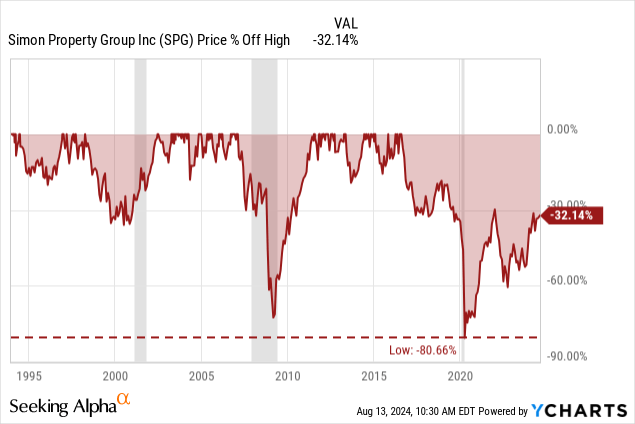 Data by YCharts
Data by YCharts
And although we are still trading 33% below its previous all-time high, the stock has more downside risk in my opinion. When looking at previous recessions, the stock declined rather steep every time. And considering that we are probably looking at another recession, the stock might decline steeply again.
Disclaimer: Investing carries risk. This is not financial advice. The above content should not be regarded as an offer, recommendation, or solicitation on acquiring or disposing of any financial products, any associated discussions, comments, or posts by author or other users should not be considered as such either. It is solely for general information purpose only, which does not consider your own investment objectives, financial situations or needs. TTM assumes no responsibility or warranty for the accuracy and completeness of the information, investors should do their own research and may seek professional advice before investing.

